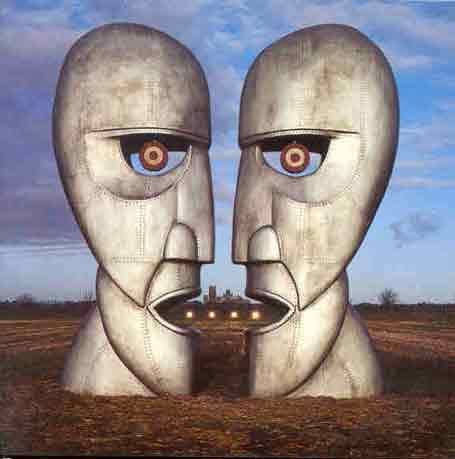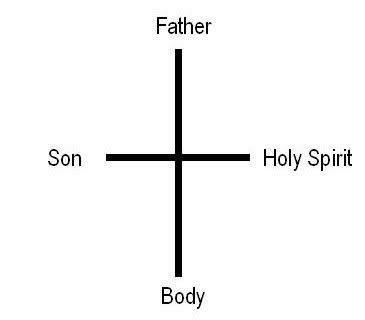This is a parallel I've found between the trinity of God and the trinity of man.
So God created man in his own image. - Genesis 1:27
First, the Holy Trinity. The Holy Trinity consists of Father, Son and Holy Spirit.
The Father is a source from which the Son is "begotten" and the Holy Spirit "proceeds". The Father is the Creator.
The Son seems to be an individuality with clear, firm boundaries of form, like a human son. He is also referred to as Logos, which in Greek means Word. All things were created through the Word. It seems that when we name things we emphasize or acknowledge their existence as individual entities, real or imaginary, but distinct from other entities. By words we define things and thus signify their boundaries that distinguish them from other things.
The Holy Spirit is also referred to as Pneuma, which in Greek means Breath. Breath indicates a diffuse, amorphous form, with unclear or indefinite boundaries. Believers are said to be "filled" with the Holy Spirit. God promises to "pour out" His Spirit. While the emanation of the Son from the Father is described by the word "begotten", the emanation of the Holy Spirit is described by the word "proceeds". The word "proceeds" seems to indicate a flowing movement while "begotten" is more like being born like a child. When the Holy Spirit is described in a concrete form it just seems to be a metaphorical description, for example a dove or tongues of fire. God uses the Holy Spirit in creating too. Interestingly, speaking of words is impossible without the flow of breath.
And now man. The cortex of the human brain consists of two hemispheres, left hemisphere and right hemisphere, and it has been found that these two hemispheres have certain specialized functions. They process information in different but complementary ways.
The left hemisphere is said to be analytic ("analysis" means "breaking up into parts") because it focuses on differentiation of details. This differentiation also seems to give rise to our sense of individuality as separate from others. And the left hemisphere is also specialized in processing of verbal language.
The right hemisphere is said to be holistic because it grasps the whole, giving us a larger picture, the context, but details within the whole fade away. It's like an intuitive diffusion of perception or thinking to a broader but less differentiated area. The right hemisphere has a role in language processing too but it captures the more fuzzy or contextual aspects of language such as metaphorical meaning and the tone of voice.
So, I would compare the consciousness of the left brain hemisphere to the Son, and the consciousness of the right brain hemisphere to the Holy Spirit. The former is a consciousness of a separate individuality and the latter is a more amorphous, less differentiated consciousness transcending the boundaries of separate individuality.
And where is the parallel with the Father? Perhaps it's an element that unifies the two perspectives, combines them and uses them in creation.

The trinity of man is often described as mind, spirit and body (or perhaps the word "soul" could also be used interchangeably with the word "mind"). Mind and spirit can be understood as the two fundamental perspectives or orientations reflected in the information processing styles of left and right brain hemispheres, respectively. Body could be seen as the unifying element that contains the two, but the problem is that the body as such doesn't seem to have the apparent will to switch between the analytic and holistic perspectives. I suppose that in man there is an element with this will, while the body is a created thing, a form through which the trinity of man expresses itself.
Finally, here is my explanation of the meaning of the cross in terms of Holy Trinity:

The upper part of the cross would be the uncreated/unmanifest/formless/God aspect of reality and the lower part of the cross would be the created/manifest/form/world aspect of reality. Son and Holy Spirit are the two fundamental perspectives or orientations. They are both contained in the formless source (Father) but they also manifest in form (Body). Body (in the most general sense any physical or mental form) is formed in time under the creative influences of Son and Holy Spirit, directed by and issuing from the source. This is creation: the undifferentiated becomes differentiated, the undefined becomes defined, the formless assumes forms, the nameless takes names, One differentiates into many, nothing becomes something.
It seems that each form is both a particle and a wave, sometimes manifesting more like a particle and sometimes more like a wave (the wave-particle duality from quantum mechanics). Particles have a definite location while waves have an indefinite location expressed in probabilities. So, each form seems to be a product of the creative influences of the defining Logos (Son) and the fuzzing Pneuma (Holy Spirit), their source being in the formless Father. Logos makes reality crystallize from the absolutely indefinite source into definite forms, while Pneuma diffuses reality back into the absolute indefiniteness of the source. But the partially indefinite Pneuma, manifested in the form of probabilistic wave, also looks like an intermediary between the definite Logos and the absolutely indefinite source.
So God created man in his own image. - Genesis 1:27
First, the Holy Trinity. The Holy Trinity consists of Father, Son and Holy Spirit.
The Father is a source from which the Son is "begotten" and the Holy Spirit "proceeds". The Father is the Creator.
The Son seems to be an individuality with clear, firm boundaries of form, like a human son. He is also referred to as Logos, which in Greek means Word. All things were created through the Word. It seems that when we name things we emphasize or acknowledge their existence as individual entities, real or imaginary, but distinct from other entities. By words we define things and thus signify their boundaries that distinguish them from other things.
The Holy Spirit is also referred to as Pneuma, which in Greek means Breath. Breath indicates a diffuse, amorphous form, with unclear or indefinite boundaries. Believers are said to be "filled" with the Holy Spirit. God promises to "pour out" His Spirit. While the emanation of the Son from the Father is described by the word "begotten", the emanation of the Holy Spirit is described by the word "proceeds". The word "proceeds" seems to indicate a flowing movement while "begotten" is more like being born like a child. When the Holy Spirit is described in a concrete form it just seems to be a metaphorical description, for example a dove or tongues of fire. God uses the Holy Spirit in creating too. Interestingly, speaking of words is impossible without the flow of breath.
And now man. The cortex of the human brain consists of two hemispheres, left hemisphere and right hemisphere, and it has been found that these two hemispheres have certain specialized functions. They process information in different but complementary ways.
The left hemisphere is said to be analytic ("analysis" means "breaking up into parts") because it focuses on differentiation of details. This differentiation also seems to give rise to our sense of individuality as separate from others. And the left hemisphere is also specialized in processing of verbal language.
The right hemisphere is said to be holistic because it grasps the whole, giving us a larger picture, the context, but details within the whole fade away. It's like an intuitive diffusion of perception or thinking to a broader but less differentiated area. The right hemisphere has a role in language processing too but it captures the more fuzzy or contextual aspects of language such as metaphorical meaning and the tone of voice.
So, I would compare the consciousness of the left brain hemisphere to the Son, and the consciousness of the right brain hemisphere to the Holy Spirit. The former is a consciousness of a separate individuality and the latter is a more amorphous, less differentiated consciousness transcending the boundaries of separate individuality.
And where is the parallel with the Father? Perhaps it's an element that unifies the two perspectives, combines them and uses them in creation.

The trinity of man is often described as mind, spirit and body (or perhaps the word "soul" could also be used interchangeably with the word "mind"). Mind and spirit can be understood as the two fundamental perspectives or orientations reflected in the information processing styles of left and right brain hemispheres, respectively. Body could be seen as the unifying element that contains the two, but the problem is that the body as such doesn't seem to have the apparent will to switch between the analytic and holistic perspectives. I suppose that in man there is an element with this will, while the body is a created thing, a form through which the trinity of man expresses itself.
Finally, here is my explanation of the meaning of the cross in terms of Holy Trinity:

The upper part of the cross would be the uncreated/unmanifest/formless/God aspect of reality and the lower part of the cross would be the created/manifest/form/world aspect of reality. Son and Holy Spirit are the two fundamental perspectives or orientations. They are both contained in the formless source (Father) but they also manifest in form (Body). Body (in the most general sense any physical or mental form) is formed in time under the creative influences of Son and Holy Spirit, directed by and issuing from the source. This is creation: the undifferentiated becomes differentiated, the undefined becomes defined, the formless assumes forms, the nameless takes names, One differentiates into many, nothing becomes something.
It seems that each form is both a particle and a wave, sometimes manifesting more like a particle and sometimes more like a wave (the wave-particle duality from quantum mechanics). Particles have a definite location while waves have an indefinite location expressed in probabilities. So, each form seems to be a product of the creative influences of the defining Logos (Son) and the fuzzing Pneuma (Holy Spirit), their source being in the formless Father. Logos makes reality crystallize from the absolutely indefinite source into definite forms, while Pneuma diffuses reality back into the absolute indefiniteness of the source. But the partially indefinite Pneuma, manifested in the form of probabilistic wave, also looks like an intermediary between the definite Logos and the absolutely indefinite source.


